ON THE ROAD, DOWN SOUTH
The timing we arbitrarily chose for our Fall travel excursion by car was fortuitous. Not long after our return to Ascoli from southern Italy, the resurgence of COVID-19 infection rates has caused the government to reinstitute more restrictive measures. In the current environment of more constrained movement and activity, I’m not sure the same travel experience would have been possible for much longer. But whatever the reason behind our timing, we are glad to have had the adventure when we did.
The broad brush of history has always interested me. The cultural history of the Mediterranean is a fascinating study of the interactions of diverse peoples over centuries. Emerging cultures expanded their reach and influence by becoming Mediterranean maritime nations. The geographic significance of the positioning of Italy is apparent. Even a cursory glimpse at a map of the Mediterranean Sea reveals the long, narrow peninsula of Italy jutting out into that large body of water. With the crisscrossing of seafaring cultures through the Mediterranean, it was inevitable that the southern tip of the Italian Peninsula sticking out as it does, would have been a stopping-off place for seafaring explorers in search of adventure and the riches they hoped to come up with. The multicultural immersion of southern Italy, with many of their residual remnants having made their mark, is just one of the reasons for it to be an interesting travel destination.
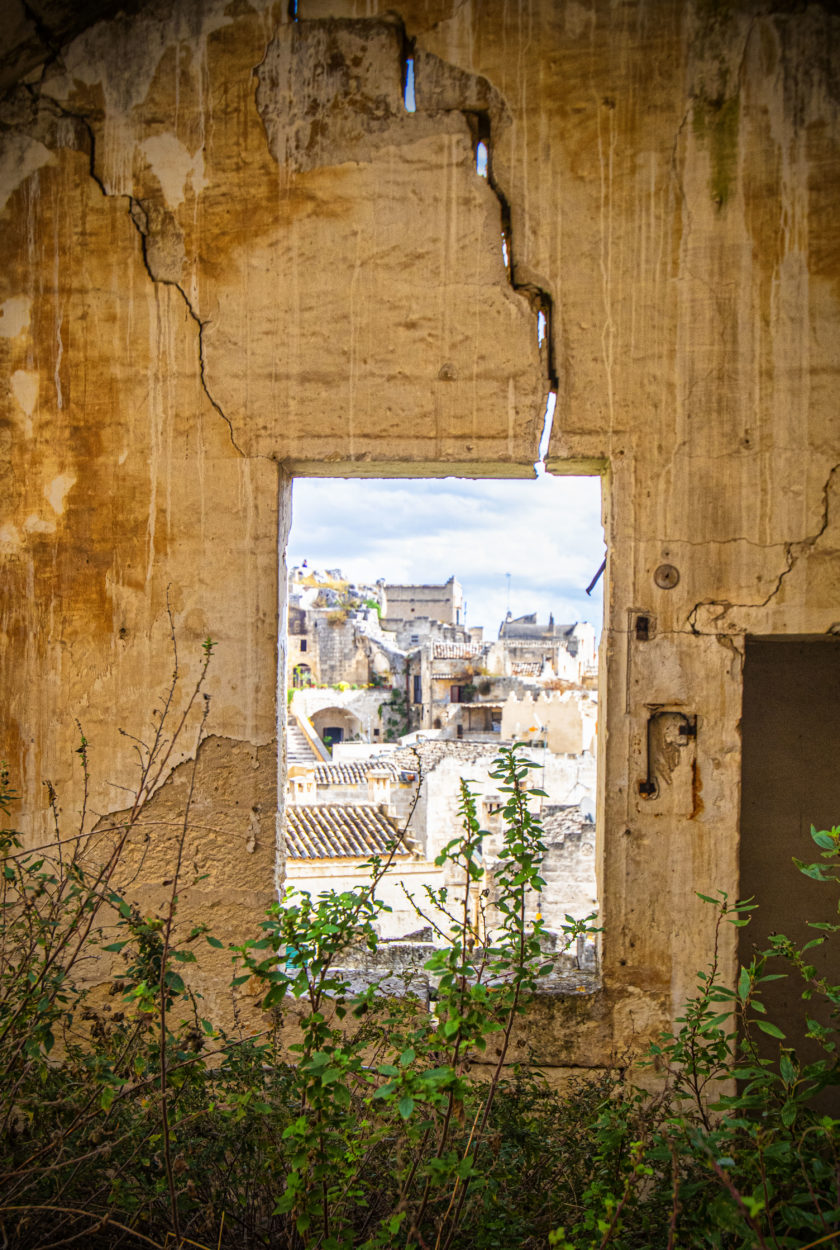
MATERA THROUGH A WINDOW IN TIME
Our most recent Blog briefly reported we had made a car excursion into southern Italy. We had set out from Ascoli in early October and headed south, on the Adriatic Coastal Plain, driving on the Autostrada A-14. After some five and a half hours, our first stop was at the ancient town of Matera in the Basilicata Region. The distinguishing feature of this area is the presence of cave dwellings that represent the oldest, known continuously inhabited, cave dwellings in the world. The cave complex has been carved into the walls of deep river canyons over time.
The imprint of human existence here is very long. The granular, calciferous rock in this area is of generally uniform texture, appearing quite solidly stable while also being responsive to early human efforts at excavation. When the first humans determined to carve into these canyon slopes to create habitations is still a matter of conjecture. Although water is available in the bottom of the valley, cave inhabitants apparently relied more on rain water filtered through porous rocks and stored in cisterns. The inadequacy of this not always plentiful resource did not promote optimal health and sanitation conditions.
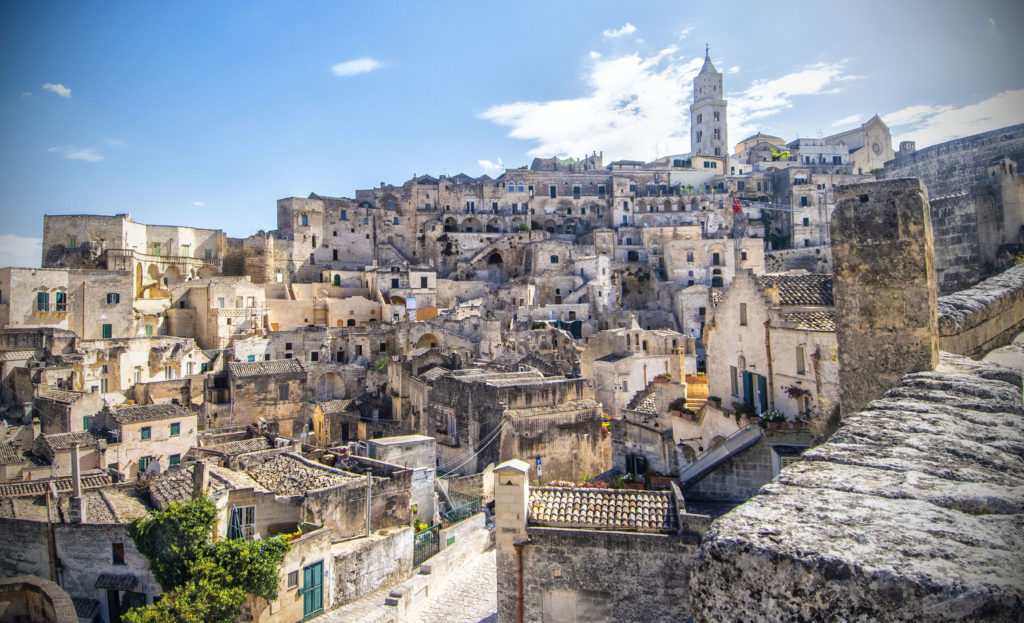
THE ‘SASSI’ OF MATERA
The cave complex is called “Sassi,” regional Italian for ‘stones. During the historic period, the predations of competing colonizing powers, from the Greeks, Romans, Teutonic Longobards, Saracens and later the Bourbon Spanish, all exploited the area. The survival alternative for the indigenous peoples was often to ‘live rough.’ The bare subsistence lifestyle of cave living in ‘squatter settlements,’ continued through generations. The resulting conditions was reflected in the reputation of the Sassi for deep poverty and desperately poor levels of sanitation. In 1952, the Italian government took drastic action and forcibly removed the inhabitants of the caves into modern housing. The area was abandoned until its potential as an historic tourist attraction was recognized. Development of hotels, restaurants and tourism services ultimately followed.
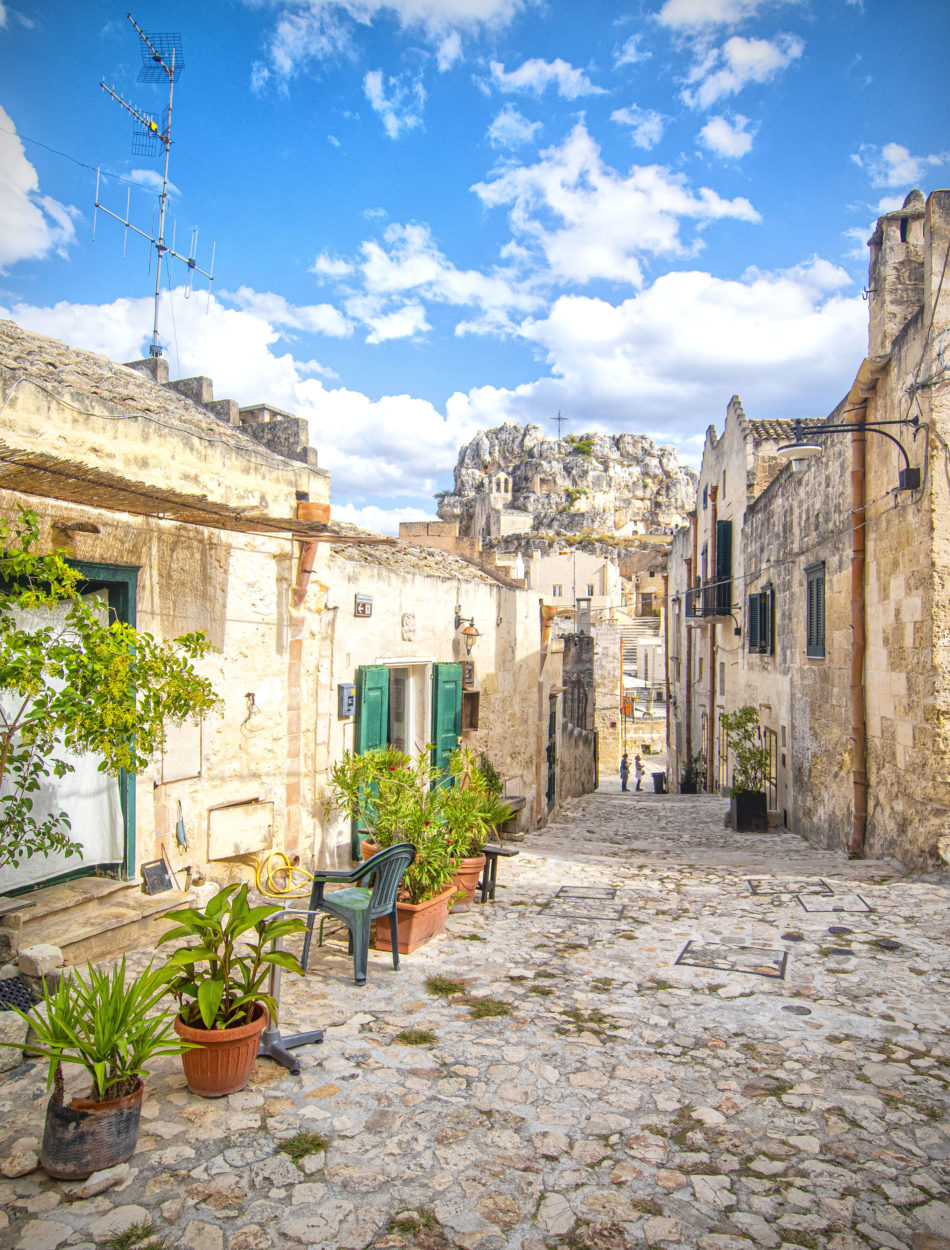
STONE IS EVERYWHERE IN THE SASSI OF MATERA
Arlene found a hotel listing in the Sassi of Matera that offered accommodation in an actual original cave that had undergone ‘modernization.’ The choice afforded welcomed COVID ‘isolation’ away from a commonly shared, hotel facilities. Driving in the valley of the Sassi is not permitted. Of necessity, we parked in the more contemporary town area and rode a shuttle into the Sassi valley floor to check into the hotel office.
Thereafter, we made the trek on foot, at least two-thirds of the way back up the steep valley slope on a seemingly, never-ending series of stone stairways. Fortunately, Arlene had done her research well. Previous visitors had advised not to bring wheeled luggage and to travel light. Even before reaching our destination, somewhere along the upward trek, on the unyielding stone steps, I decided ‘light’ had become very relative.
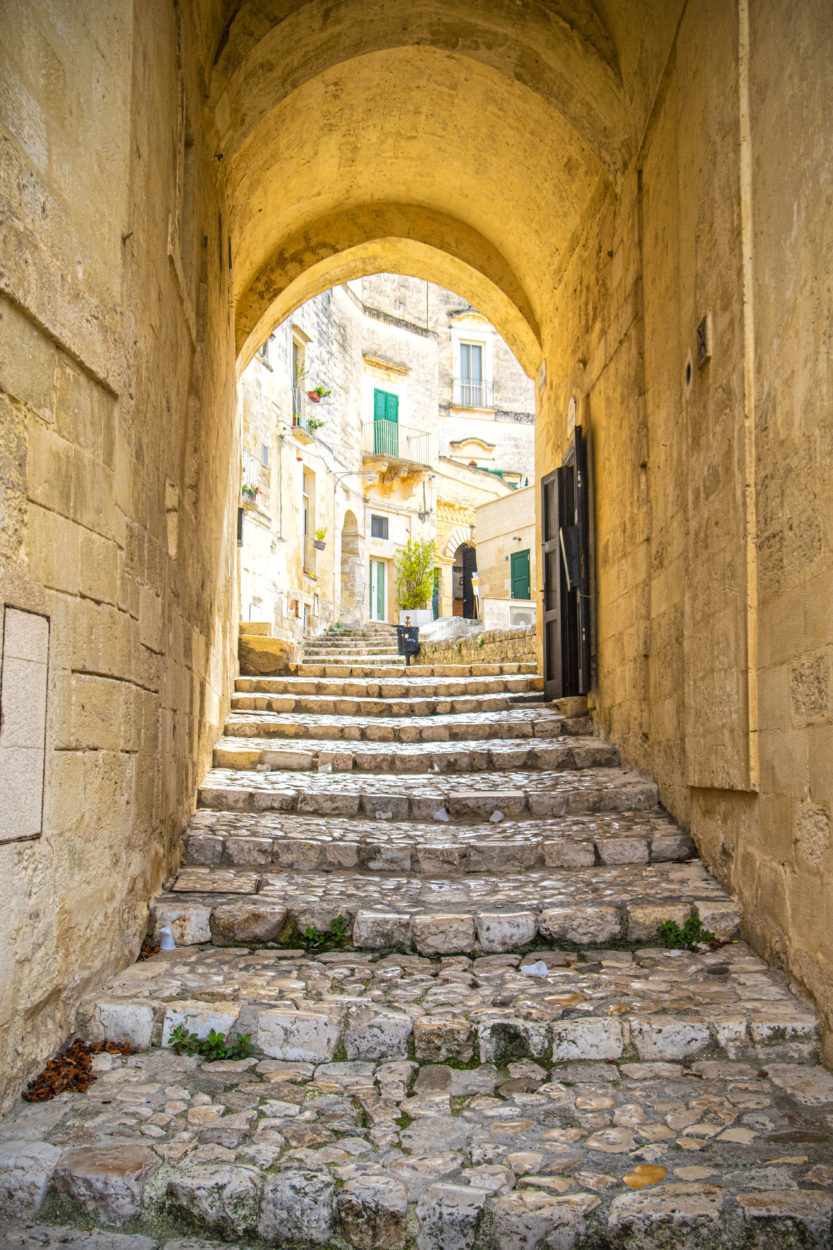
THE PATH TO OUR CAVE
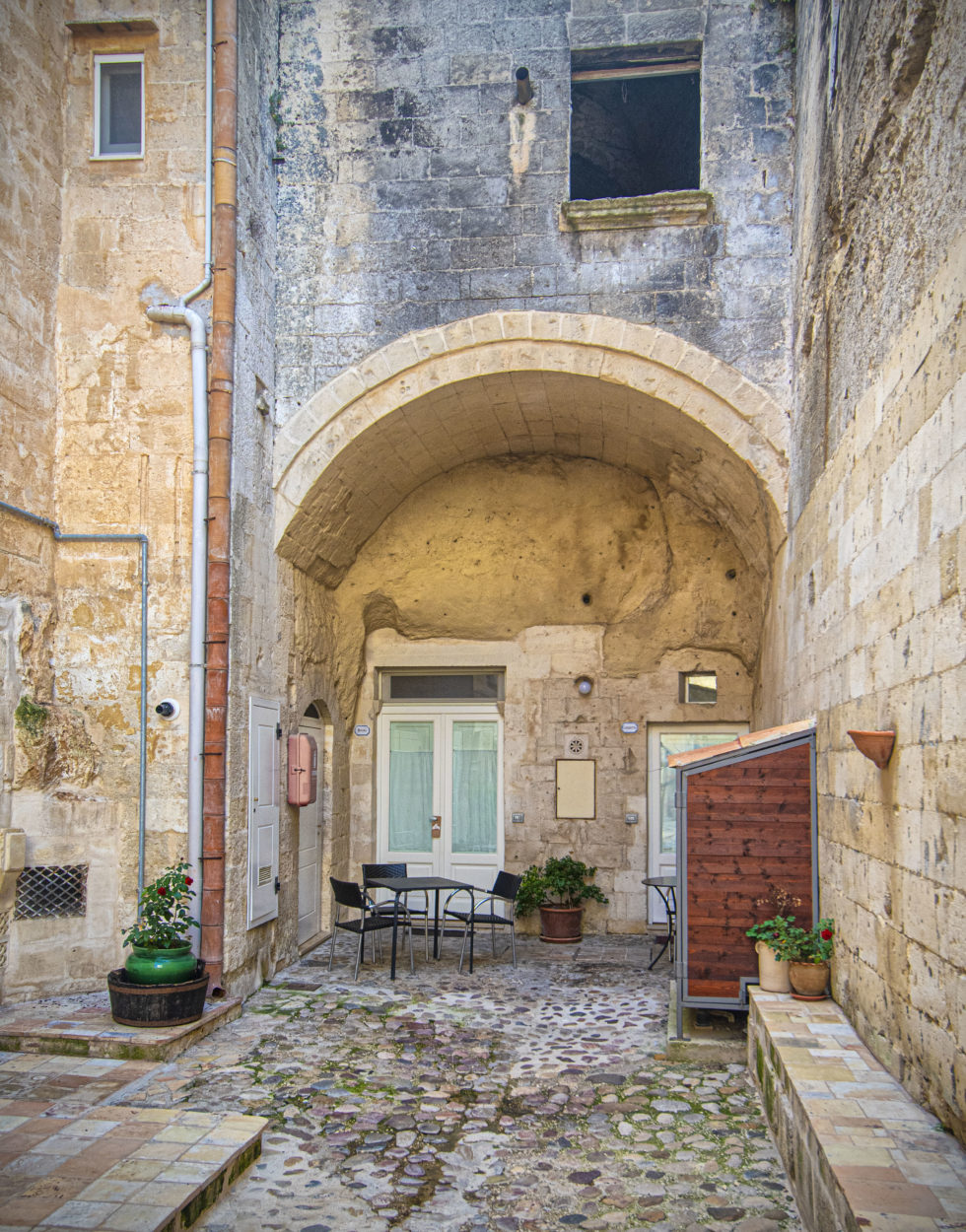
OUR CAVE ‘FRONT DOOR’
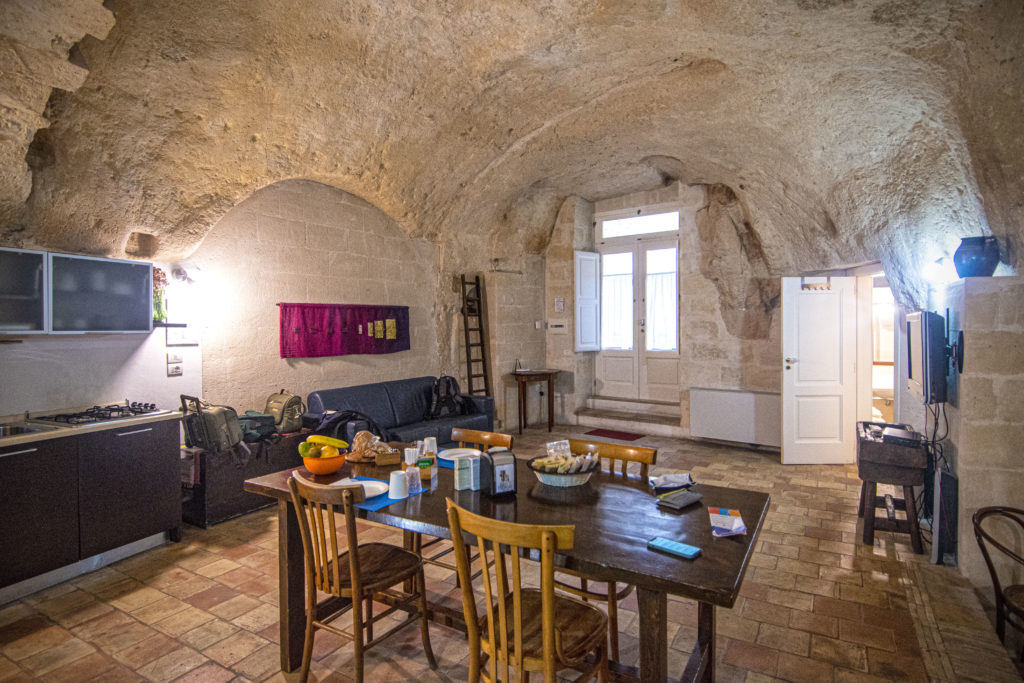
CAVE LIVING WITH A MODERN FLAIR
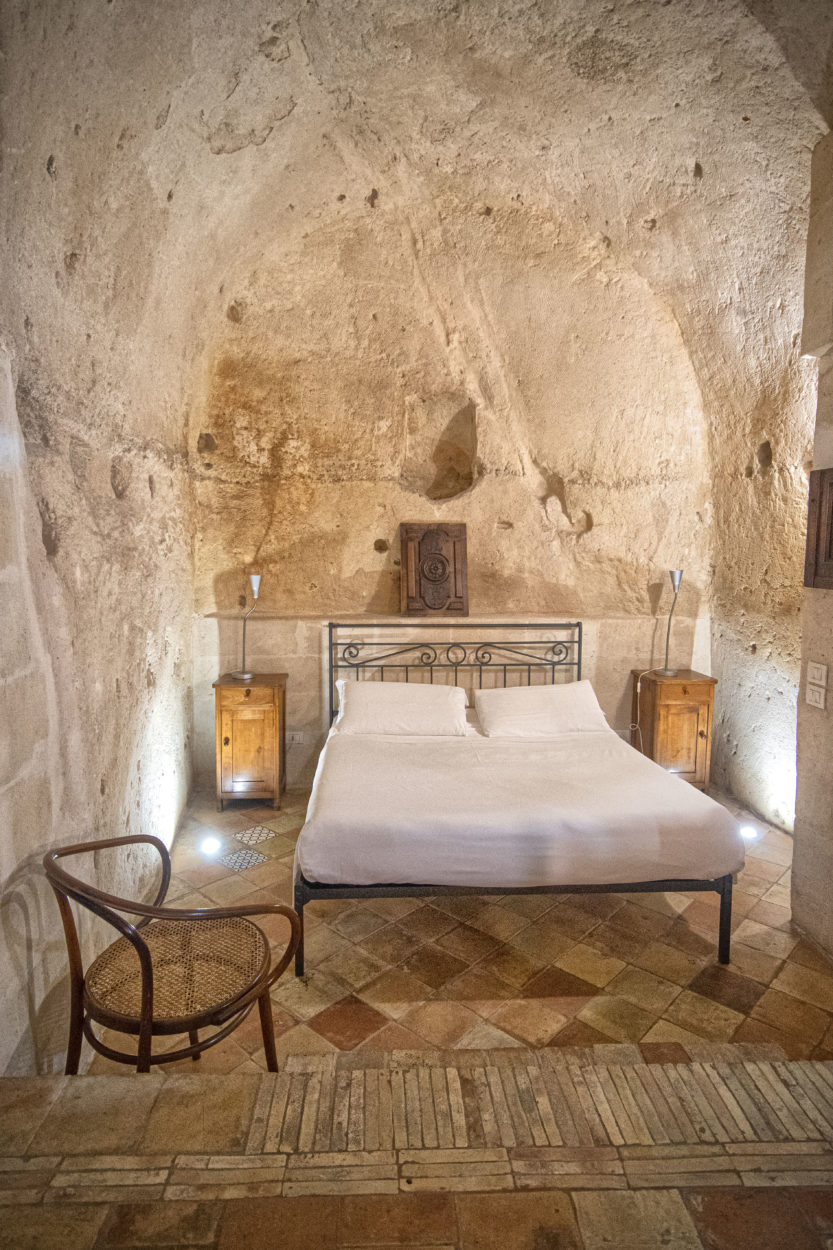
CAVE MAN AND CAVE WOMAN BEDROOM
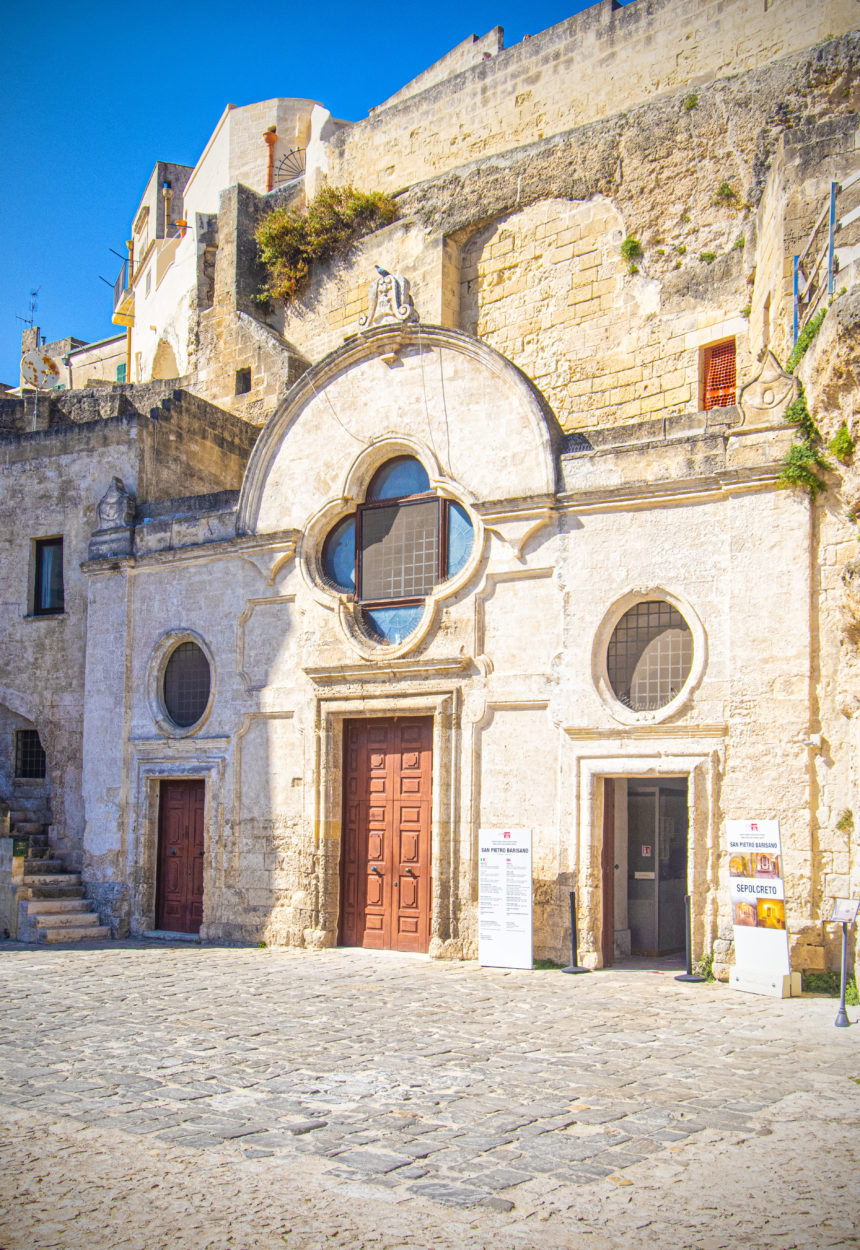
FACADE OF A CHURCH CAVE – A FORMER RELIGIOUS COMMUNITY
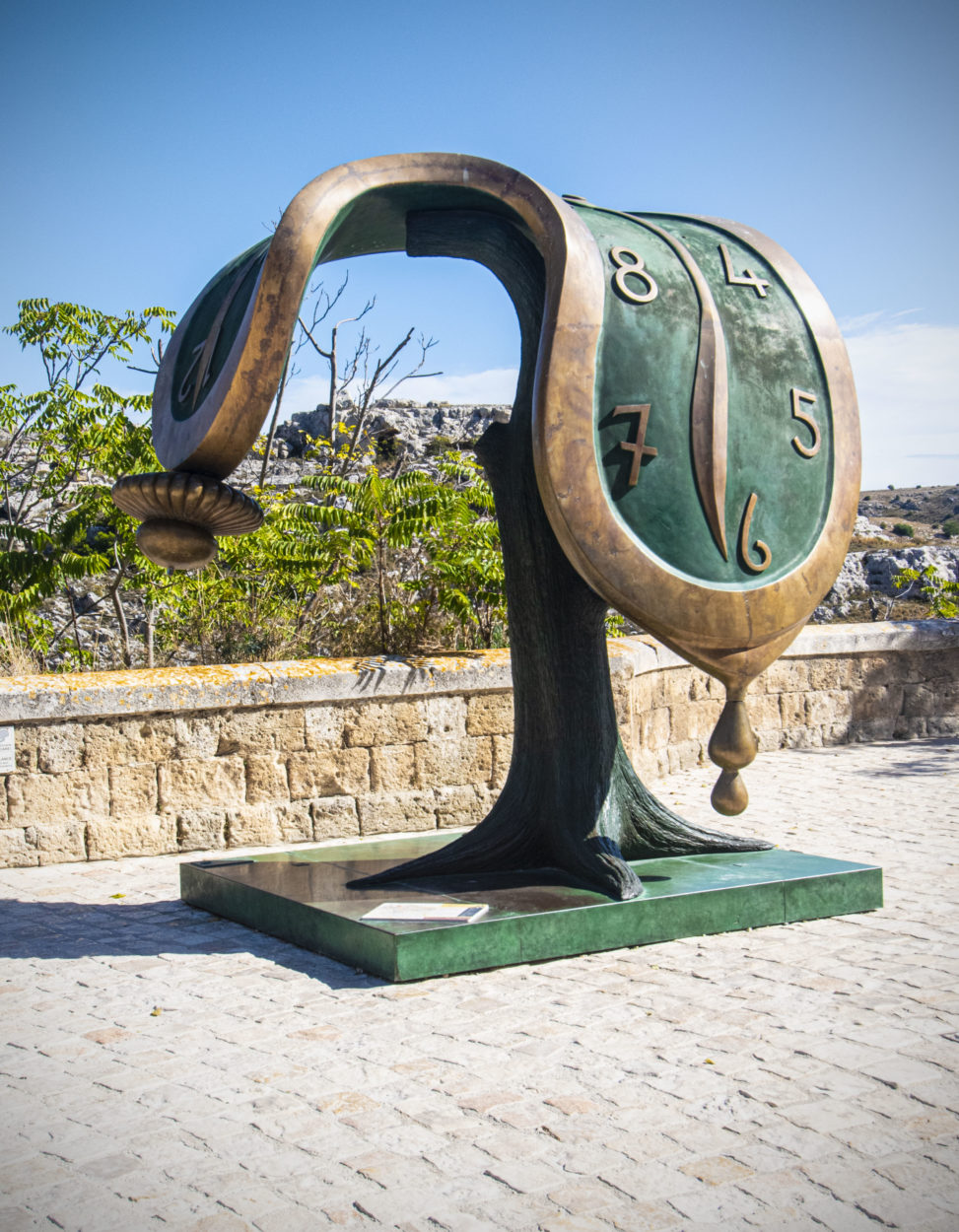
SALVATOR DALI’ WORK IN MATERA – WHERE TIME DOES SEEM FLUID
ON TO ALBEROBELLO
After two nights and a full day of exploring the Sassi valley slopes of Matera, we retrieved our car from the garage where it had been parked and set off. We had decided to make a stop for sightseeing and a midday meal at Alberobello in the Puglia Region. The distinguishing feature of Alberobello is the proliferation of a style of smaller building architecture called ‘Trulli.’ These unique buildings feature conical, stone roofs. The Trulli of Alberobello were named a UNESCO World Heritage site in 1966.
Early inhabitants of the area discovered the readily available, local stones composed mainly of limestone, naturally formed into parallel blocks of varying thickness. The relatively smooth and parallel surfaces were readily adaptable to make excellent materials requiring little reworking to be functional for building.
During the extended period of southern Italian domination by the Spanish Royal Court, taxation enforced from colonial authorities in Naples, levied a tax on the assessed value of permanent structures. As the Alberobello limestone building materials could be erected without the use of mortar, avoidance of taxation was claimed on the basis that the structures were ‘temporary.’ There are stories that in some cases, the occupants of the Trulli dismantled them when facing an assessment evaluation only then to ‘reassemble them’ once the ‘tax man’ had left. The time-honored Italian tradition of being ‘furbo,’ shrewd, and evasion of taxation, appears to have deep historic roots.
Perhaps, it may have been the steady drizzle that began earlier and affected the level of my appreciation of Alberobello. Also, a predisposition from a somewhat critical comment I had read earlier may have colored my perceptions. The remark was something to the effect, “If you want to see an example of how to do tourism wrong, go to Alberobello.” From what I saw in the area of the greatest concentration of Trulli, virtually every available doorway on the main thoroughfares was dominated by tourist ‘stuff.’ I confess to not being a fan of mass tourism so any reminder tends not to excite me. I found what I was seeing a little ‘off-putting’ and a distraction from what I wanted to see and understand.
But to be fair, in areas without a diversified economy, tourism can be the principle source of income to support people’s livelihoods. I keep reminding myself about that. The antidote we found was to get off the main tourist area thoroughfares and wander the back lanes. Additionally, there were some very well done and tasteful exhibits, in particular the Trullo Sovrano Casa Museum. It had been the home of the local priest who had come from a prominent family. That worthwhile exhibit gave an excellent feel for what life in a Trullo could be like, at least for someone of prominence.
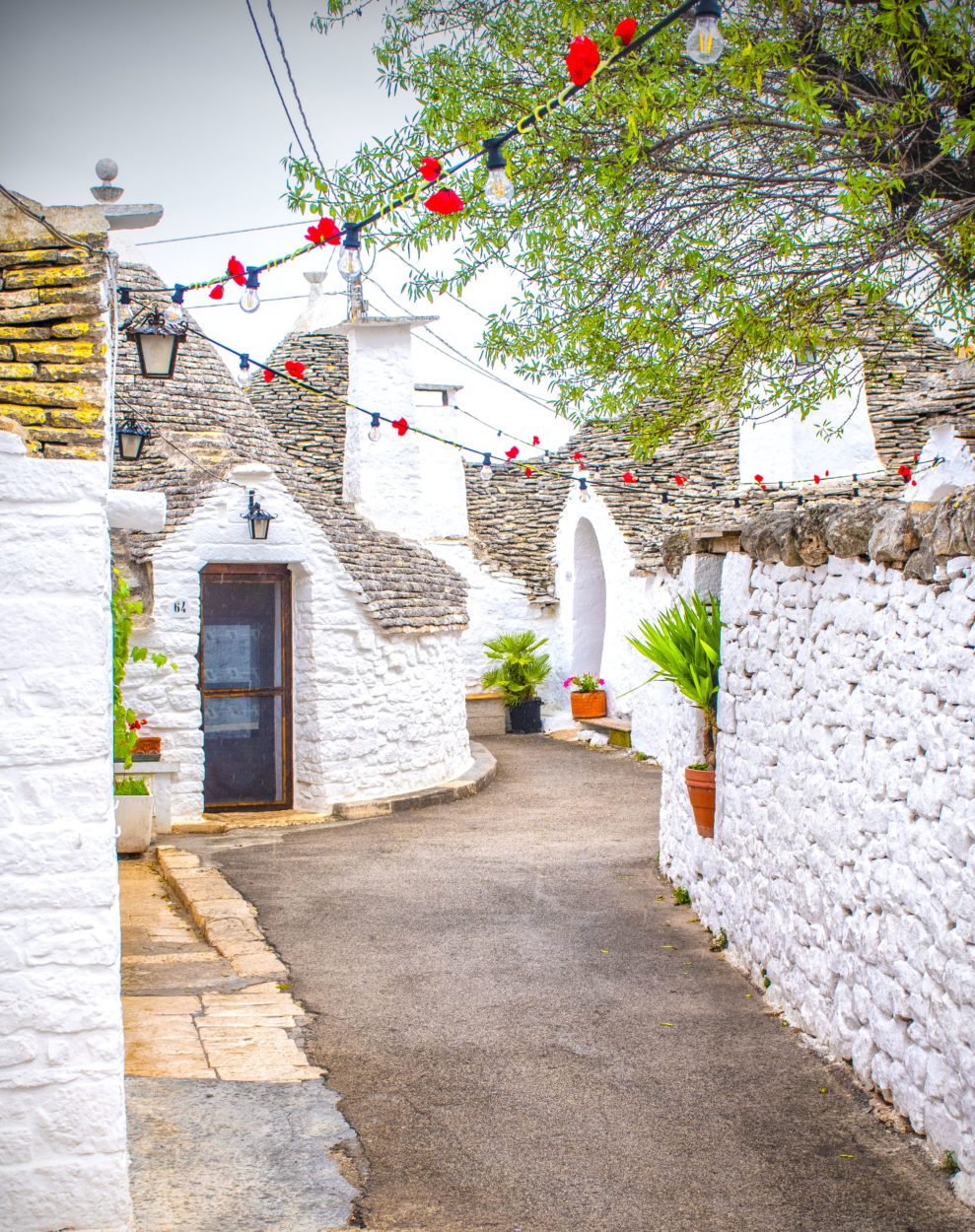
A LANE OF TRULLI IN ALBEROBELLO
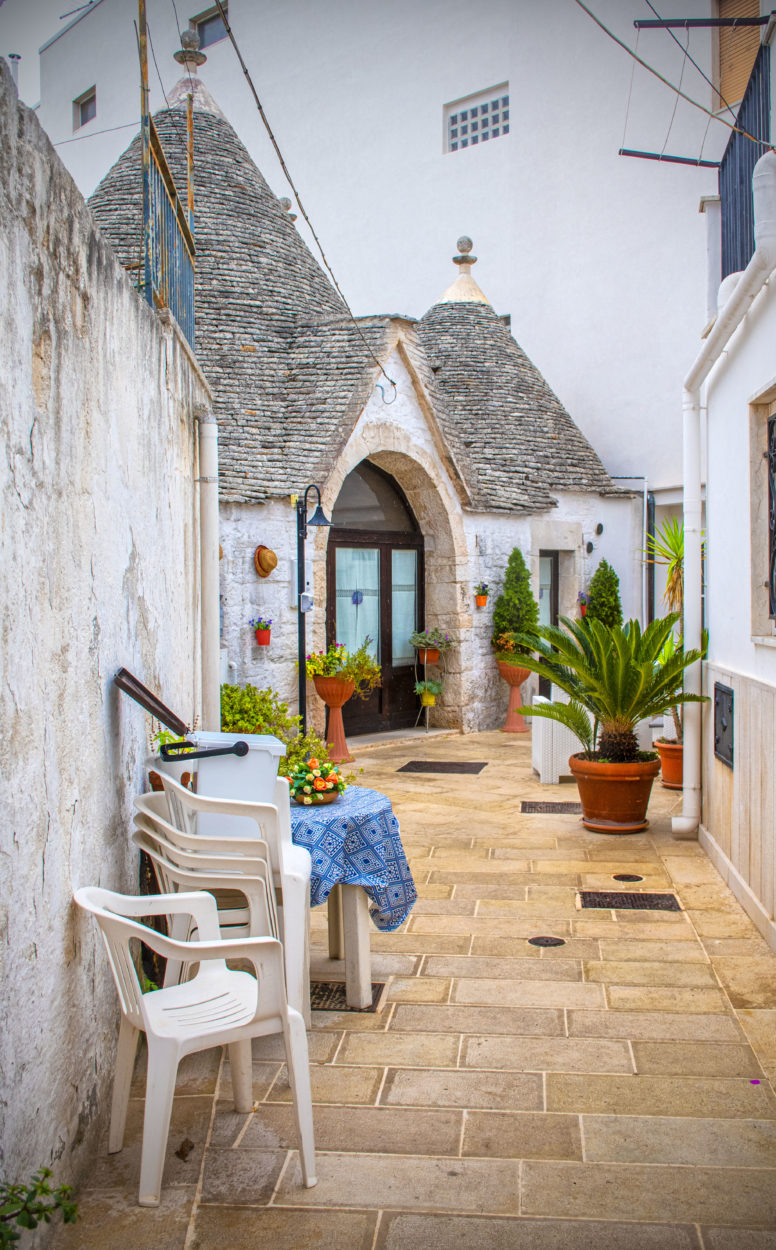
TRULLI SANDWICHED BETWEEN CONTEMPORARY BUILDINGS.
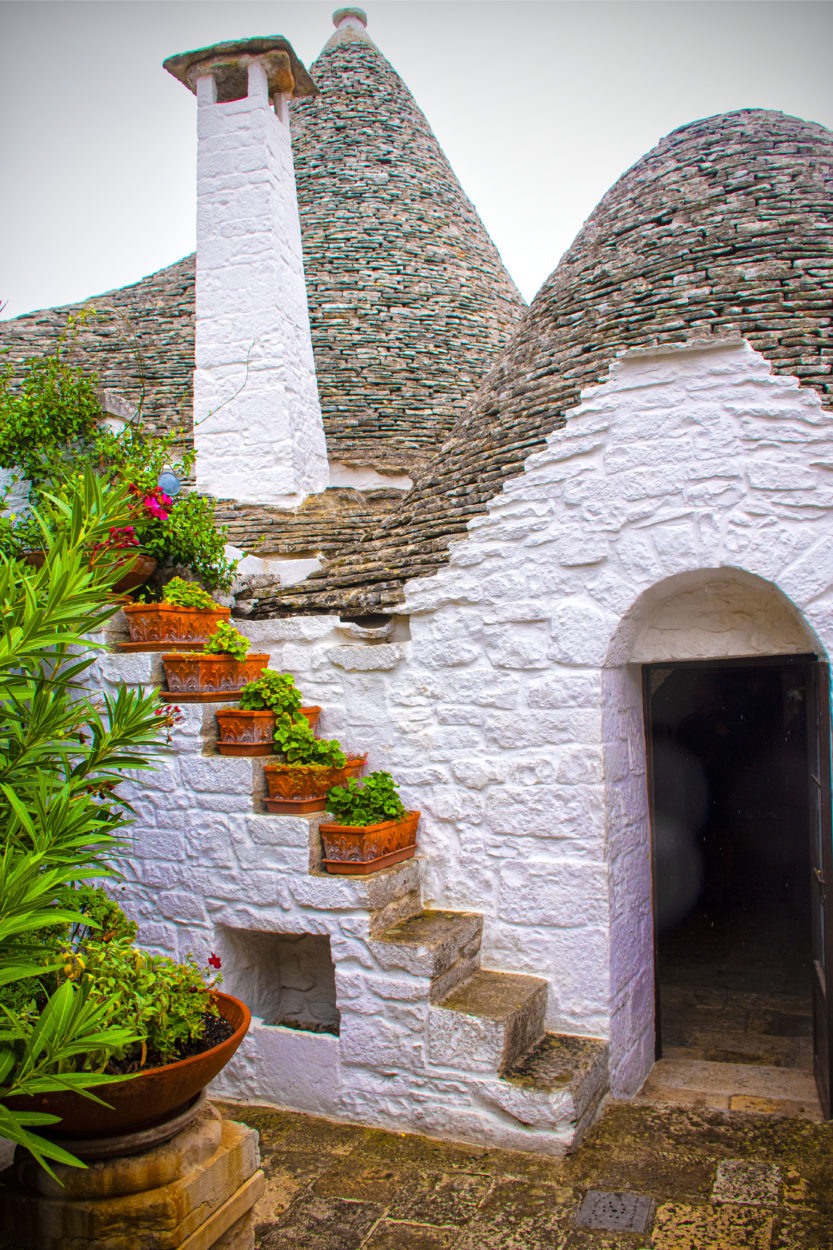
ROOF AND CHIMNEY DETAIL OF THE TRULLO SOVRANO CASA MUSEUM
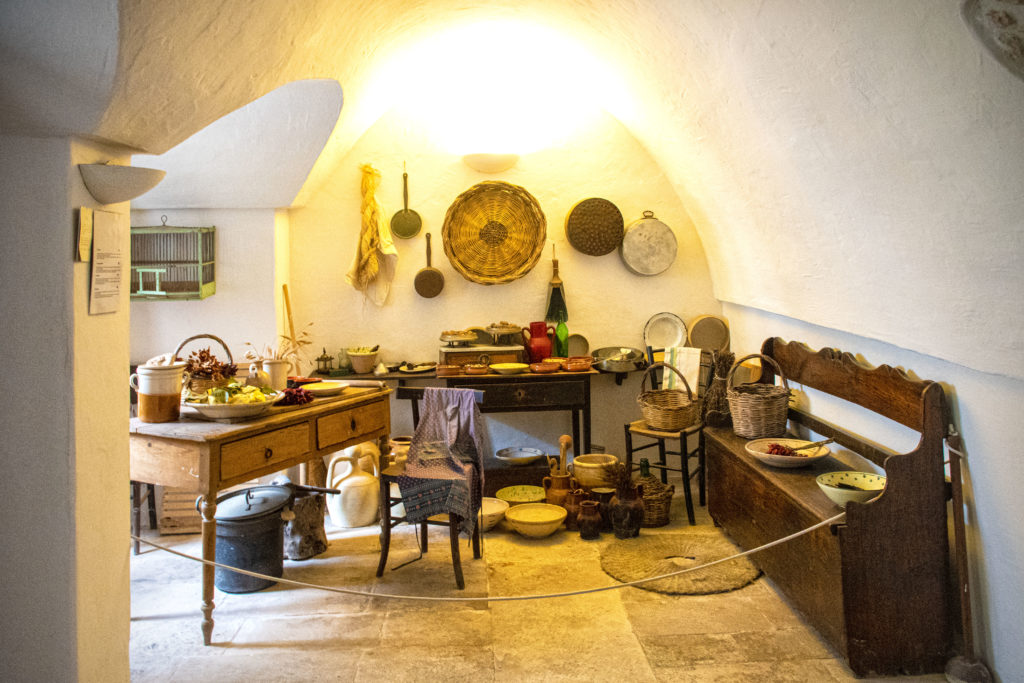
INTERIOR OF THE TRULLO SOVRANA CASA MUSEUM
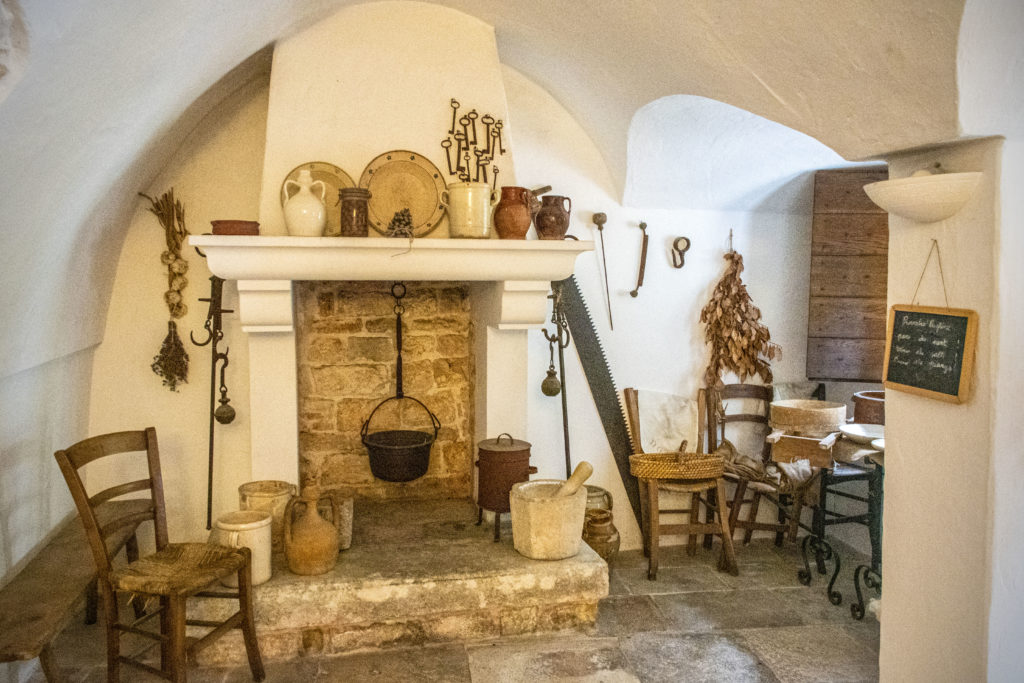
INTERIOR OF THE TRULLO SOVRANA CASA MUSEUM
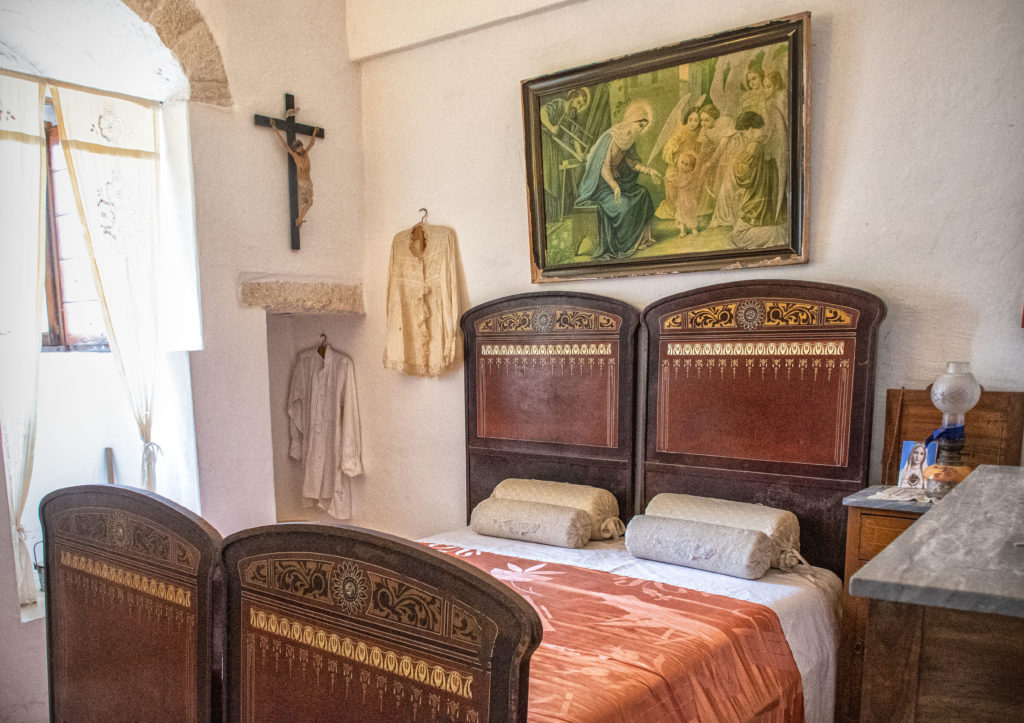
INTERIOR OF THE TRULLO SOVRANA CASA MUSEUM
ON TO LECCE
After a pleasant midday meal in Alberobello, we headed toward Lecce during the midafternoon. And with our departure, the rain intensified. Alberobello is in a more sparsely settled area away from the main, multi-laned highway systems. As a result, the one-and-a-half-hour drive toward Lecce was on two lane roads in the rain, at times heavy. Fortunately, a sure-footed car equipped with a GPS navigation system, reduced some of the stress. Except for the inevitable road construction detours, not always well marked, we arrived in front of our Lecce hotel in the late afternoon without complications.
Fortunately, by the time of our arrival in Lecce, the all-day rain had lightened up. As is one of her many talents, Arlene had chosen a very pleasant, small hotel in the central area of Lecce, within easy walking distance of the principal sites. The attentive staff couldn’t have been more gracious. The small hotel was located on an upper floor in a building off the square in front of the Church of Saint Chiara. The ‘boutique hotel’ consisted of only four rooms with a very large roof-top terrace. In more accommodating weather, the terrace could be a pleasant place to enjoy the provided breakfast or just relax. Our room faced the street and large French doors opened onto a small balcony just large enough to stand on to survey the street below.
I find it fascinating to stay in these older buildings that were probably once residences of people of consequence, in a now bygone era. Trying to imagine what it had originally been like and how it was modified, stimulates my curiosity.
The room was airy and well-lit with natural light. The only drawback was the presence of a Café four stories below that was a popular nighttime venue. But double glazing, shutters and drapes made that workable. By morning the rain had stopped, and a hazy sunshine took its place, along with a strong wind. Apparently, a weather front had transited the area during the night and unequal atmospheric pressure zones we still in the process of interacting.
With its position on the Adriatic side of the southern ‘heel-of-the-Italian-boot,’ over its very long history, Lecce had been ‘host’ to a very wide variety of Mediterranean cultures, each leaving their mark. It was in a very favorable geographic position to become a hub for trade. As a result, Lecce developed into one of the more prosperous centers in this maritime immersed part of Italy. Some historians have asserted the city was founded by sea farers from Crete. Elements of Greek influence are still identifiable in Lecce.
Fortunately for the arts, areas in which some level of commercial, economic success had flourished, a corresponding support of creative life can be in evidence. The Florence of the Medici immediately comes to mind. In fact, there is some commentary referring to Lecce as “The Florence of the South.” To my mind, that suggestion seems to underscore the extent to which the arts were supported here by the substantial class. Given the pivotal role of Florence in providing energy to the Renaissance Europe-wide, I tend to feel a broader comparison of Lecce with Florence might be a bit generous.
Within easy walking distances in the center of Lecce, the long history of the impact of divergent cultures is readily available for viewing. A very well-preserved seating area of a Roman-era amphitheater is a centerpiece.
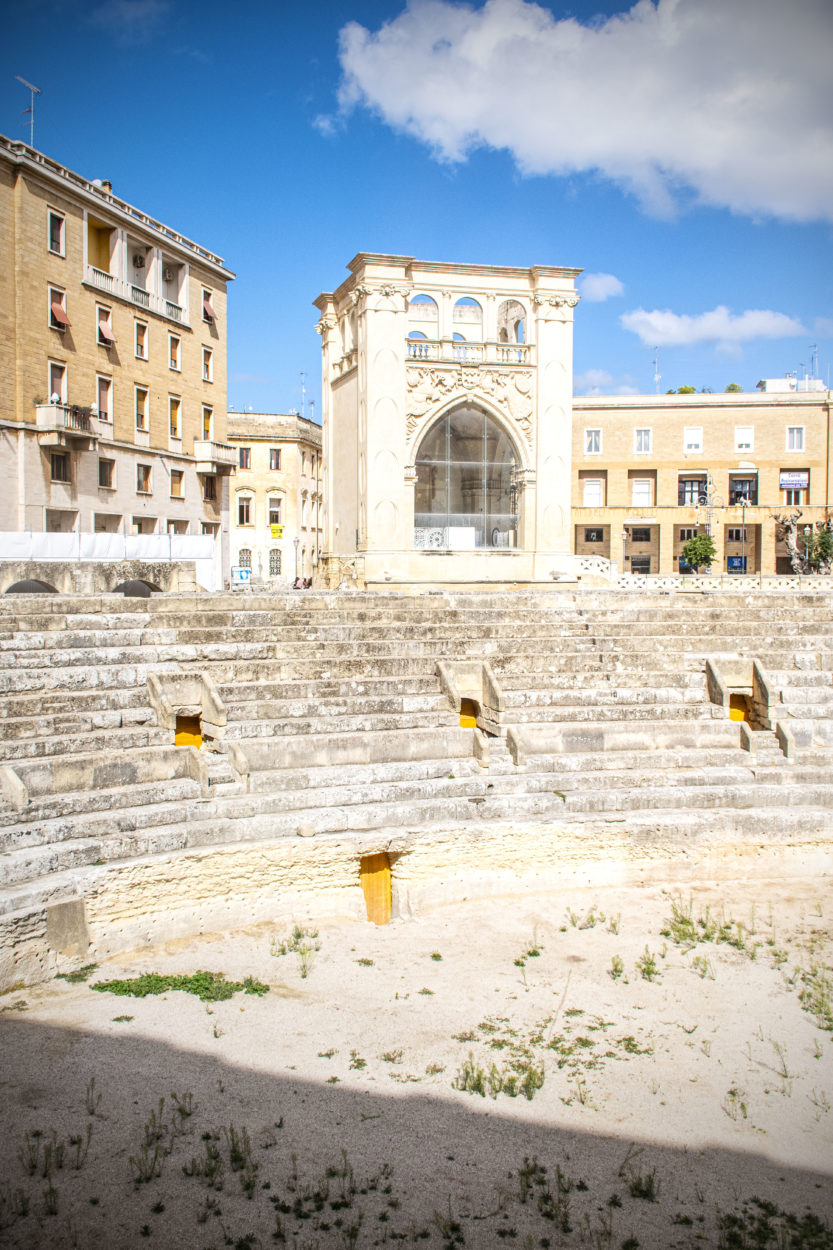
ROMAN-ERA AMPHITEATER IN CENTRAL LECCE
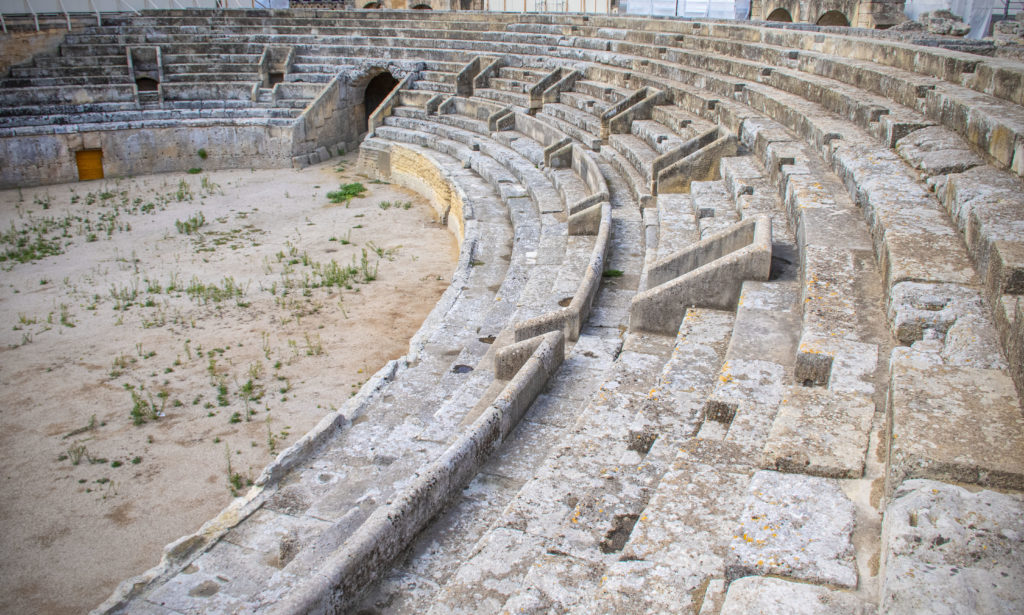
ROMAN AMPHITEATER SEATING DETAIL
When it comes to architecture and the decorative arts, Lecce is a rich resource in which to explore southern European expressions of the Baroque. Several cultural commentators have observed the flamboyant artistic style, identified as Baroque, got an impetus in the Counter-Reformation response of the Vatican. It has been said that Baroque was an attempt by the Vatican to “Out Bling” the Reformation.
To me, Baroque artistic expressions in the European-Mediterranean areas have a feeling of greater flamboyance compared with the Baroque style encountered further north in Europe. I sense, the Baroque expressions in Lecce had more in common with what we had enjoyed in Seville in Spain than we had experienced elsewhere.
Well, yes of course. Southern Italy was the seat of the Bourbon Spanish crown’s, Kingdom of Sicily territory for over four centuries. Some have suggested that the Spanish in turn bear an imprint of a flamboyance emanating from direct interaction with North African cultural influence.
In the Saint Giovanni Cathedral Square, sits a wonderful example of Baroque architecture, The Seminary of the Bishop of Lecce. The façade of the building appears grounded in the formalism of the Renaissance style of Palladio, but raises the ante with Baroque decoration.
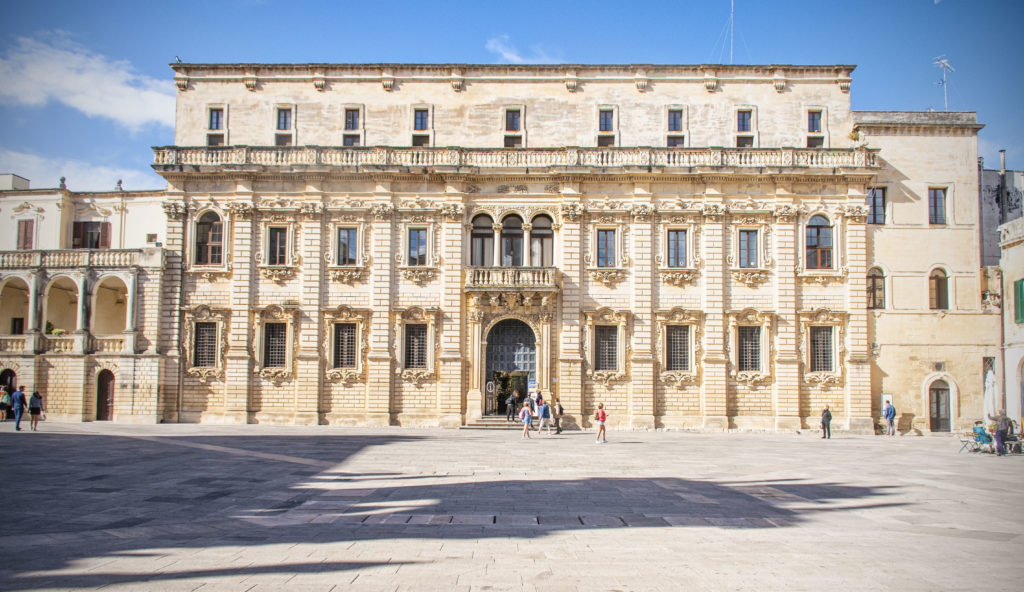
THE SEMINARY ON THE CATHEDRAL SQUARE
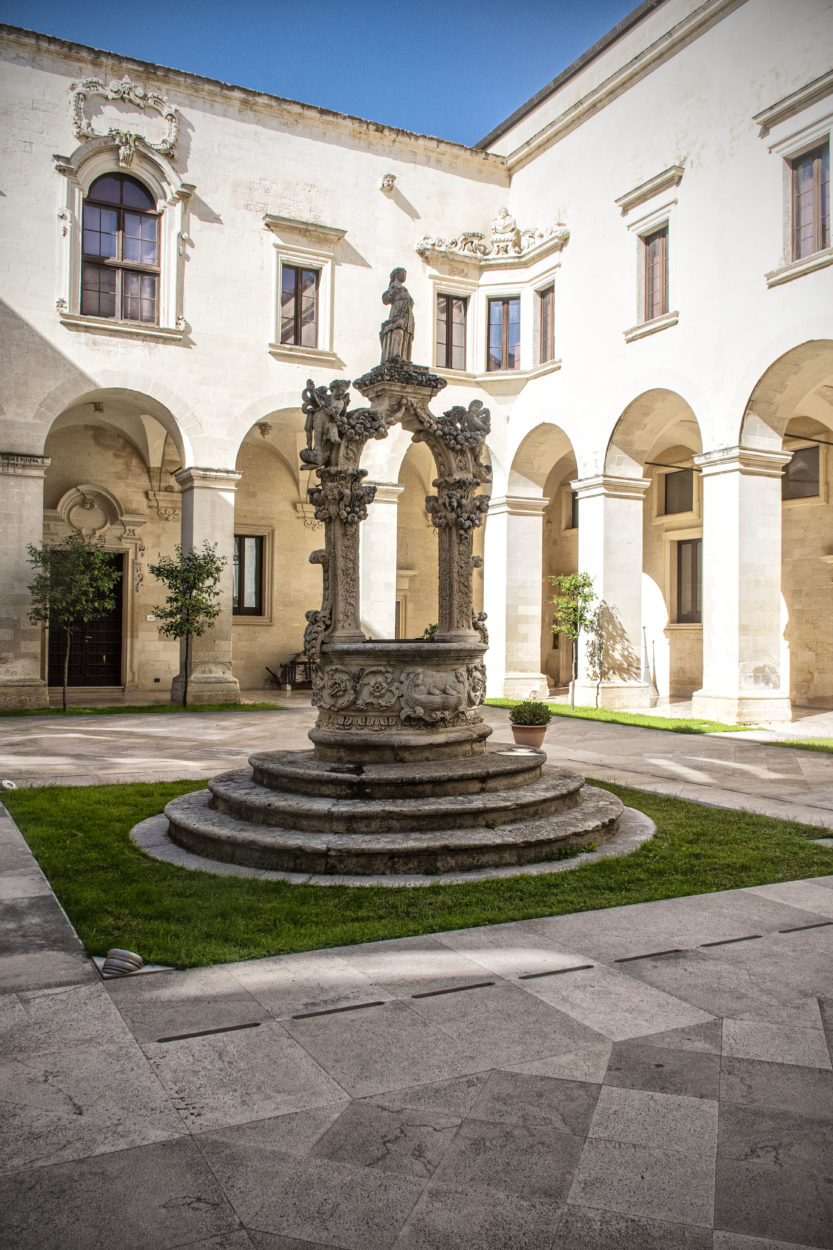
SEMINARY COURTYARD IN THE BAROQUE-STYLE
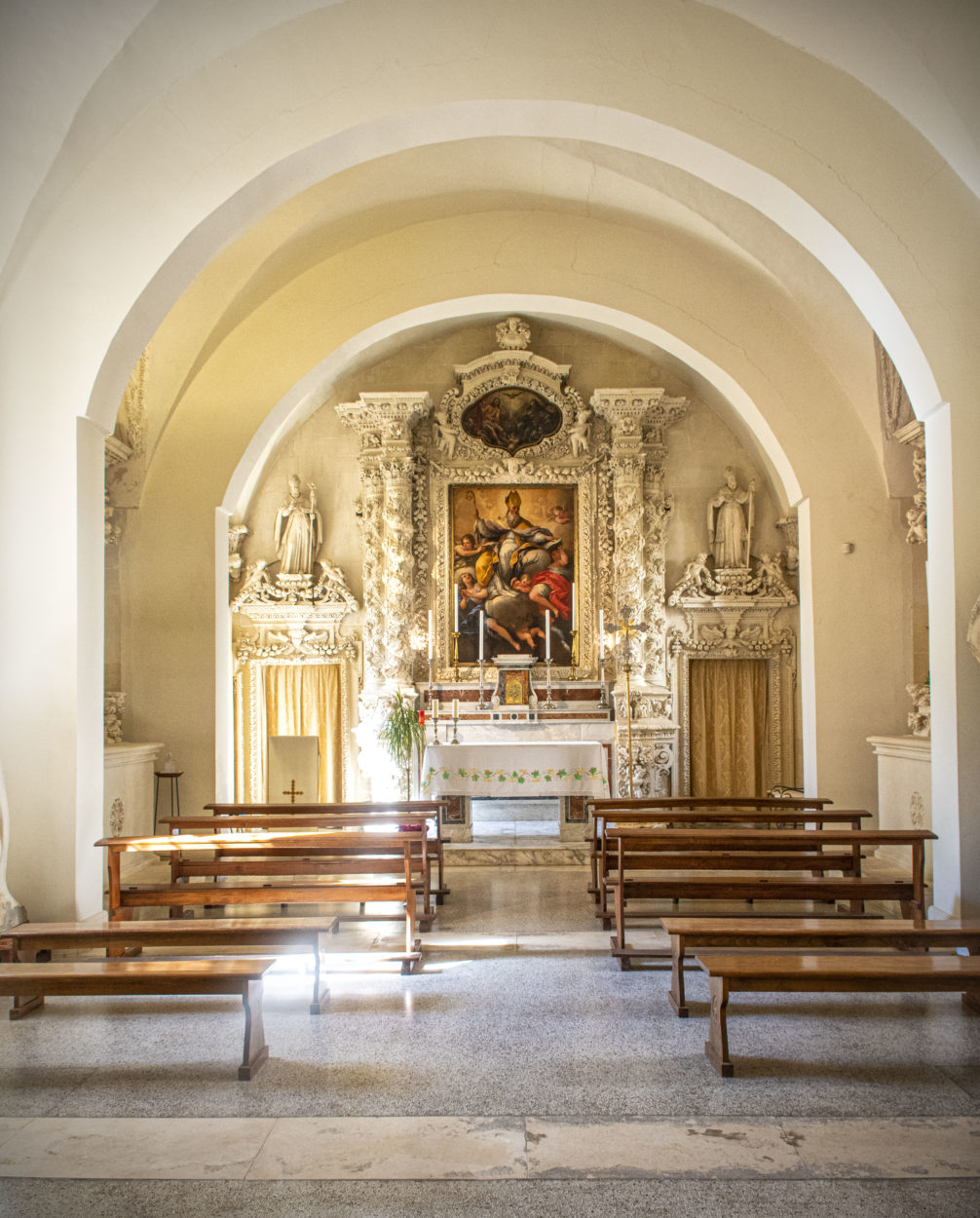
SEMINARY CHAPEL
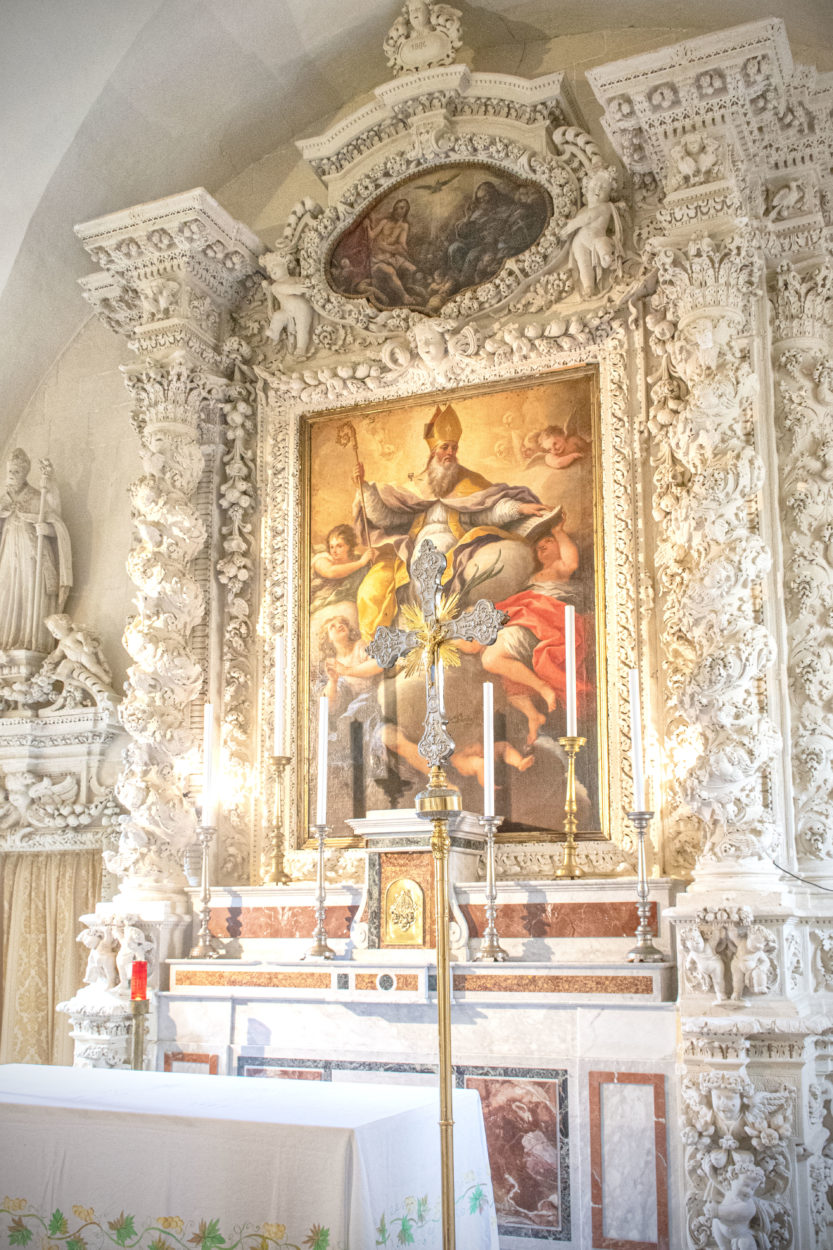
SEMINARY CHAPEL ALTAR DETAIL
Baroque decoration reaches an even richer expression in the Cathedral of Lecce dedicated to Saint Giovanni. Translucent glass windows flood the nave with natural light, highlighting the rich decoration. The apparent message of the church was to convey to believers, whose lives were steeped in hardship, what you see is a taste of the glories you will have in heaven – as long as you adhere to the faith.
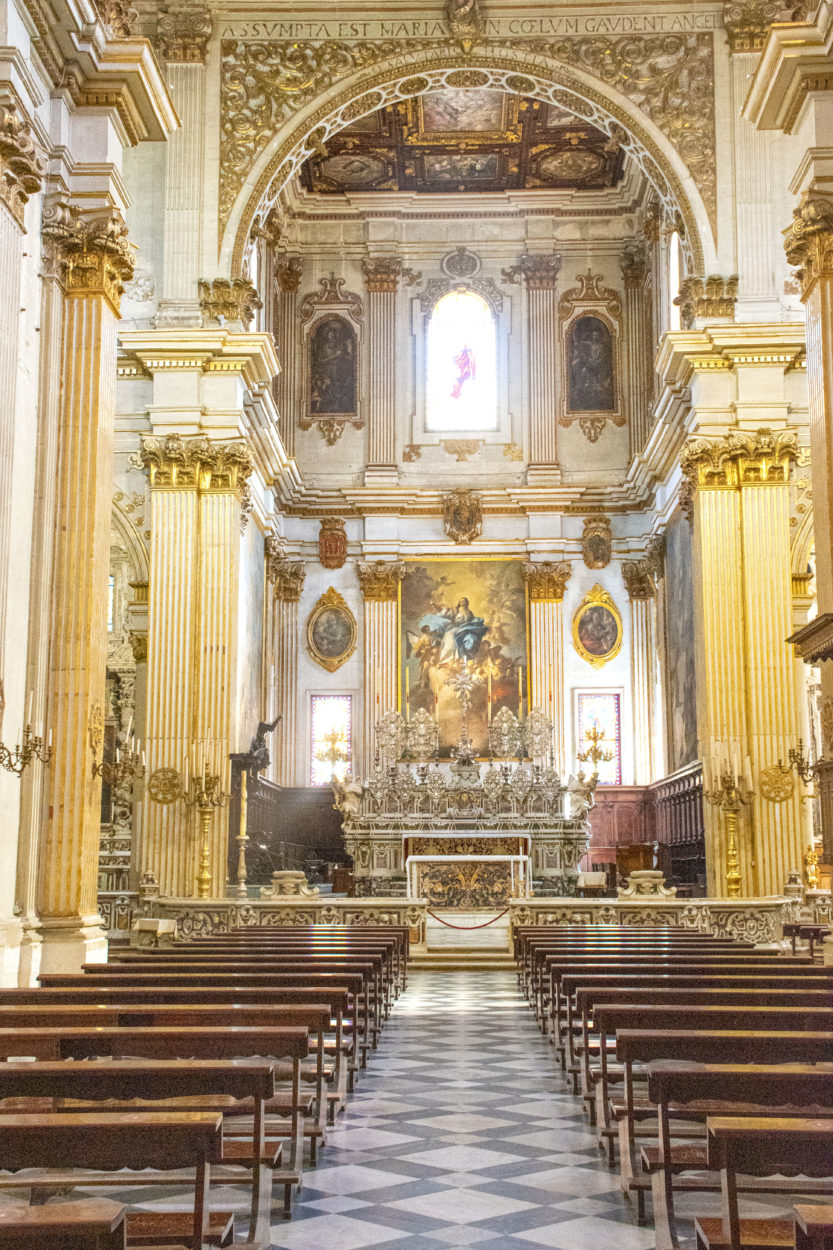
CATHEDRAL OF SAINT GIOVANI NAVE AND ALTAR
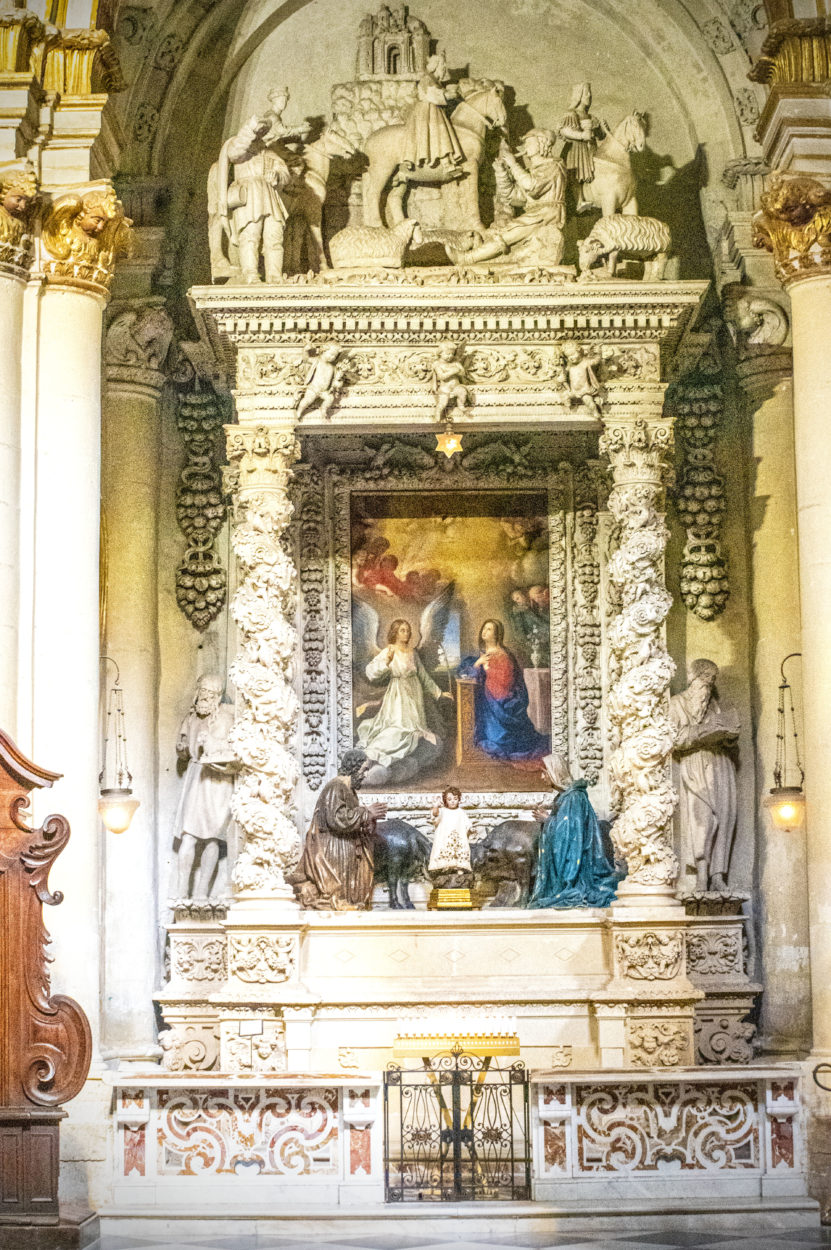
CHAPEL OF THE NATIVITY IN THE CATHEDRAL OF SAINT GIOVANNI
A very conspicuous remnant of the effect major power politics has had on Lecce is the existence of the Fortress of Charles the Fifth. Charles the Fifth, King of France, became the Holy Roman Emperor after his ending of the rule of the Austrian Hohenstaufen dynasty in the early 16th century. He had an imposing fortification built in Lecce as a base to secure his dominance over this territory. The strategic position of Lecce made it a target for competing powers, in this case, the Ottoman expansion out of the eastern Mediterranean.
It had been the fate of Italy to be under various non-Italian powers since the fall of the Roman Empire. The opposition to the fragmentation of Italy under non-Italian domination became the rallying incentive that ultimately lead to the uprising resulting in the unification of Italy in the late nineteen century. The spark for that movement began in southern Italy.
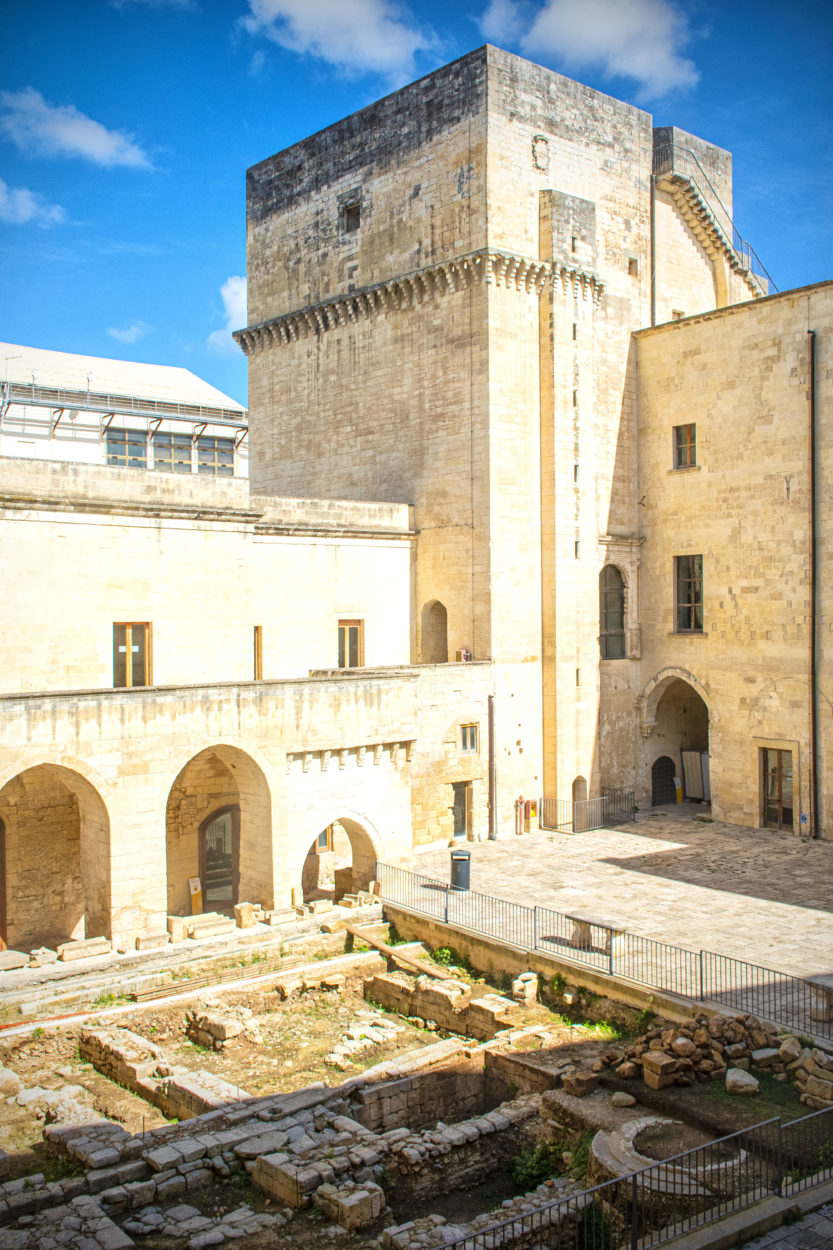
CENTRAL COURTYARD OF THE FORTRESS OF CHARLES V. MAIN DEFENSIVE TOWER AND REMNANTS OF THE FORTRESS SUPPORT BUILDINGS
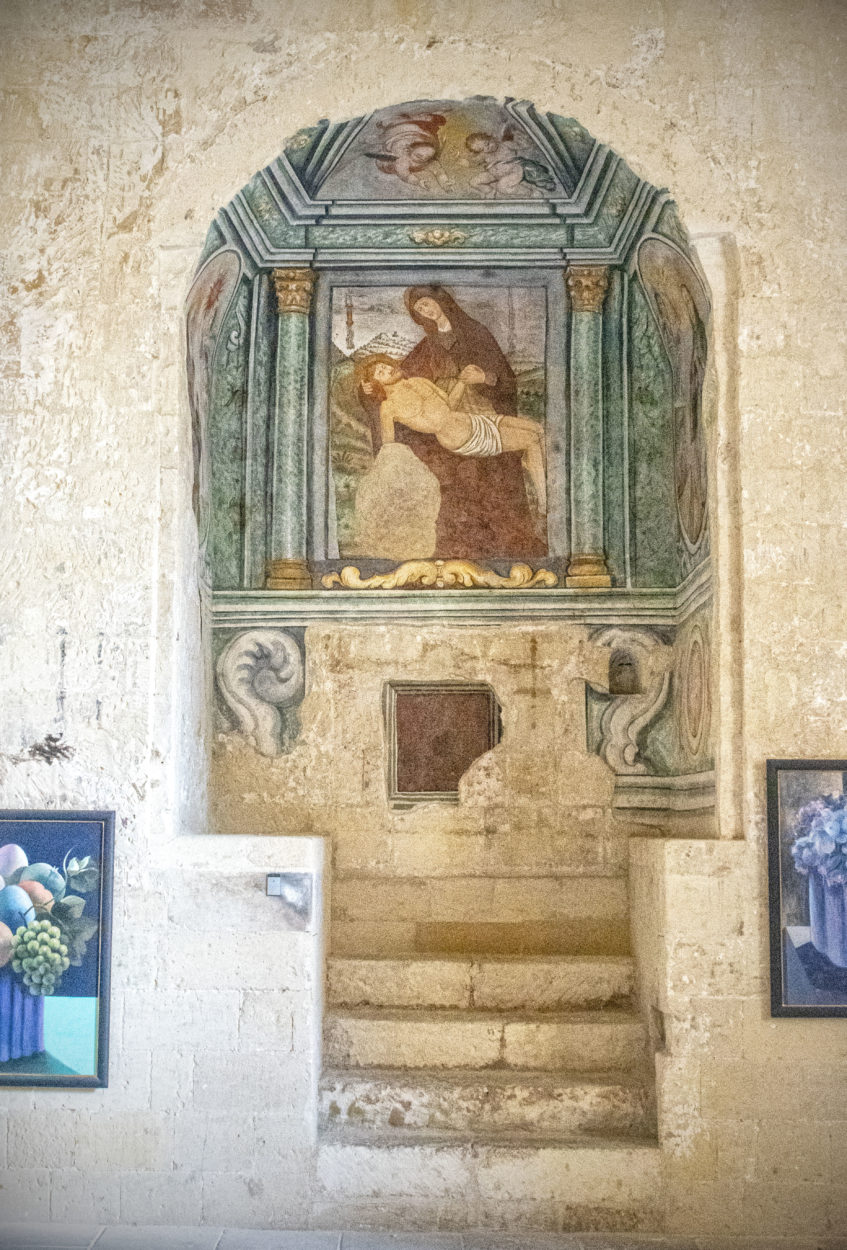
DEVOTIONAL CHAPEL IN THE FORTRESS WALL
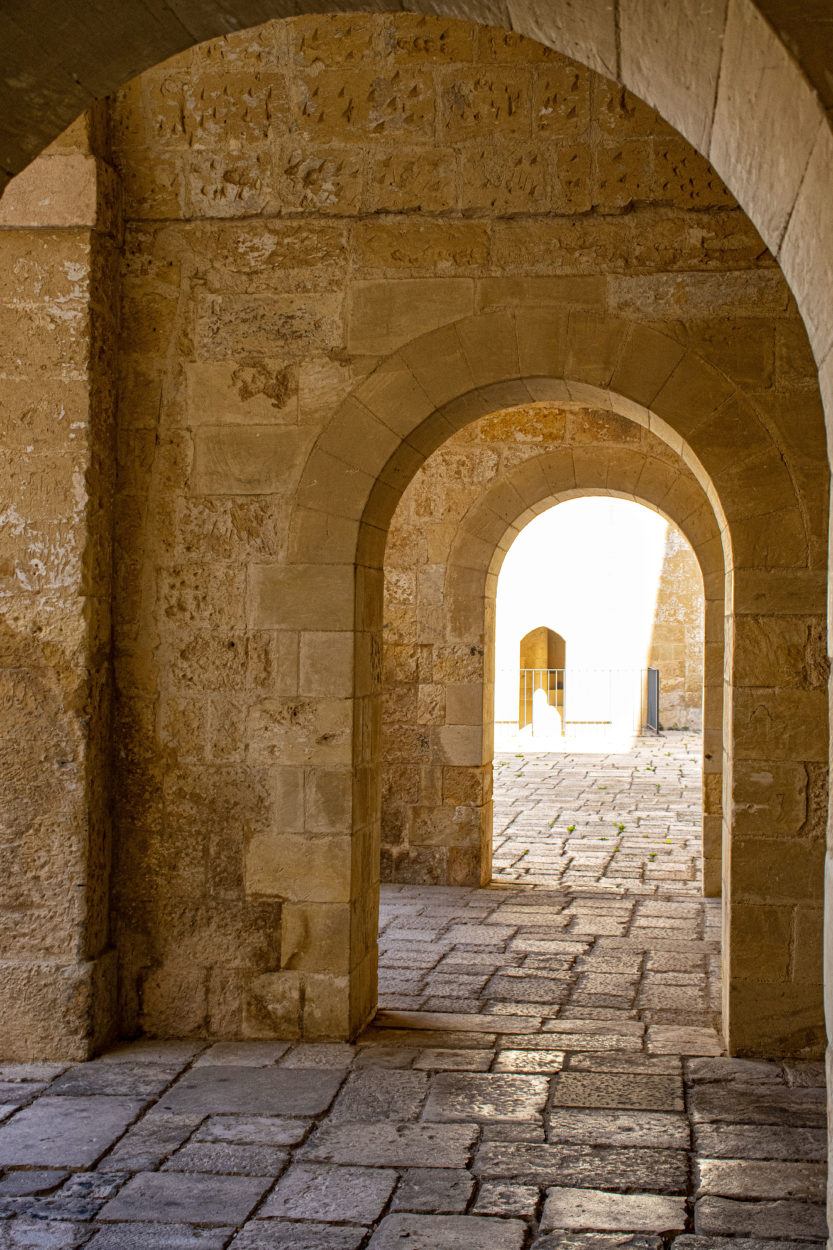
FORTRESS INTERIOR PASSAGEWAYS
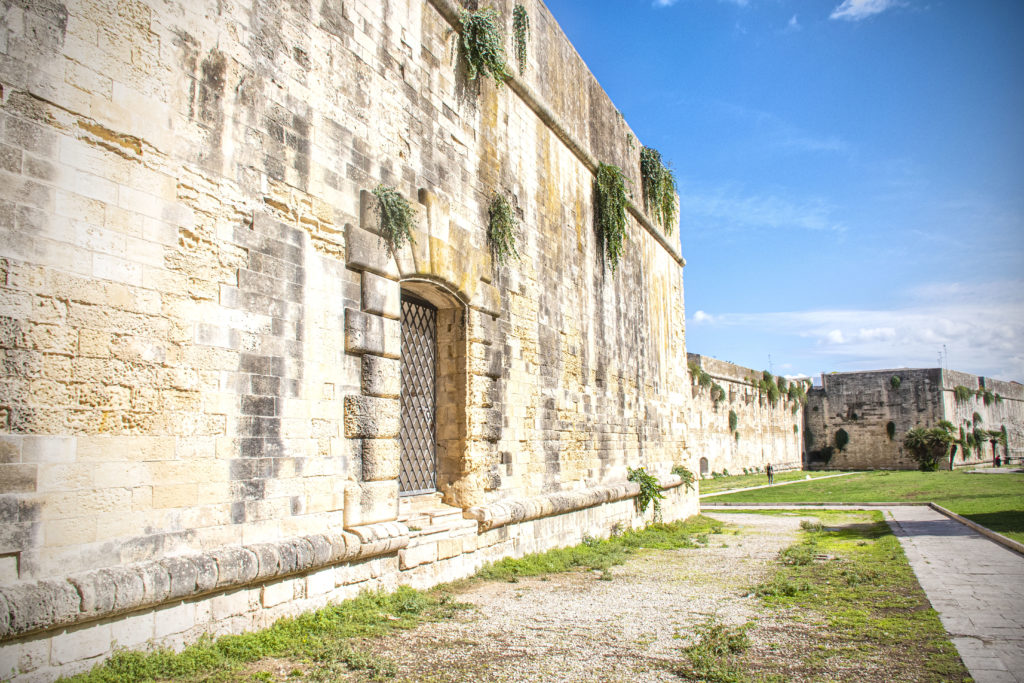
OUTER WALLS OF THE FORTRESS OF CHARLES V
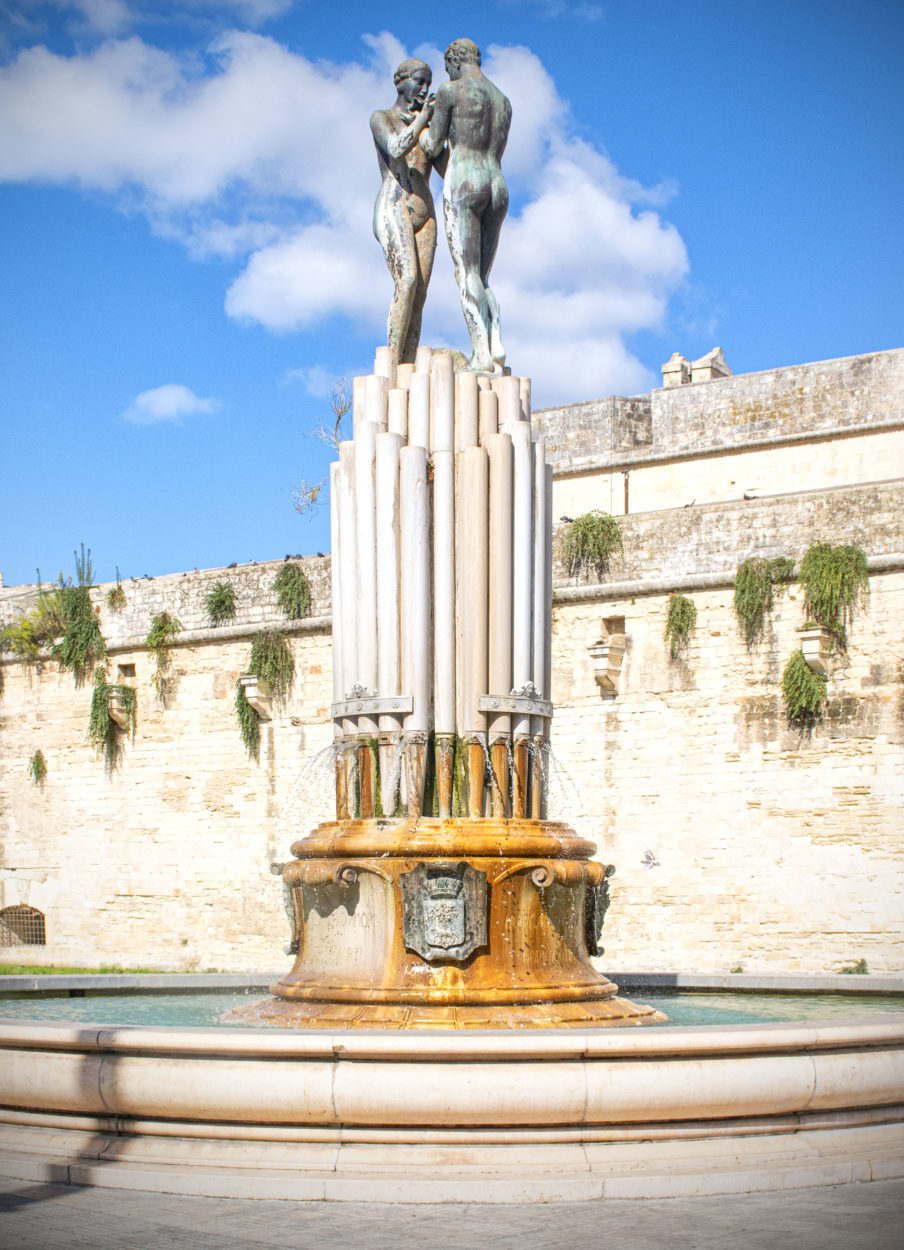
A MODERN SCULPTURAL INTERPRETATION OF AFFECTION AGAINST THE BACKDROP OF A MILITARY FORTIFICATION
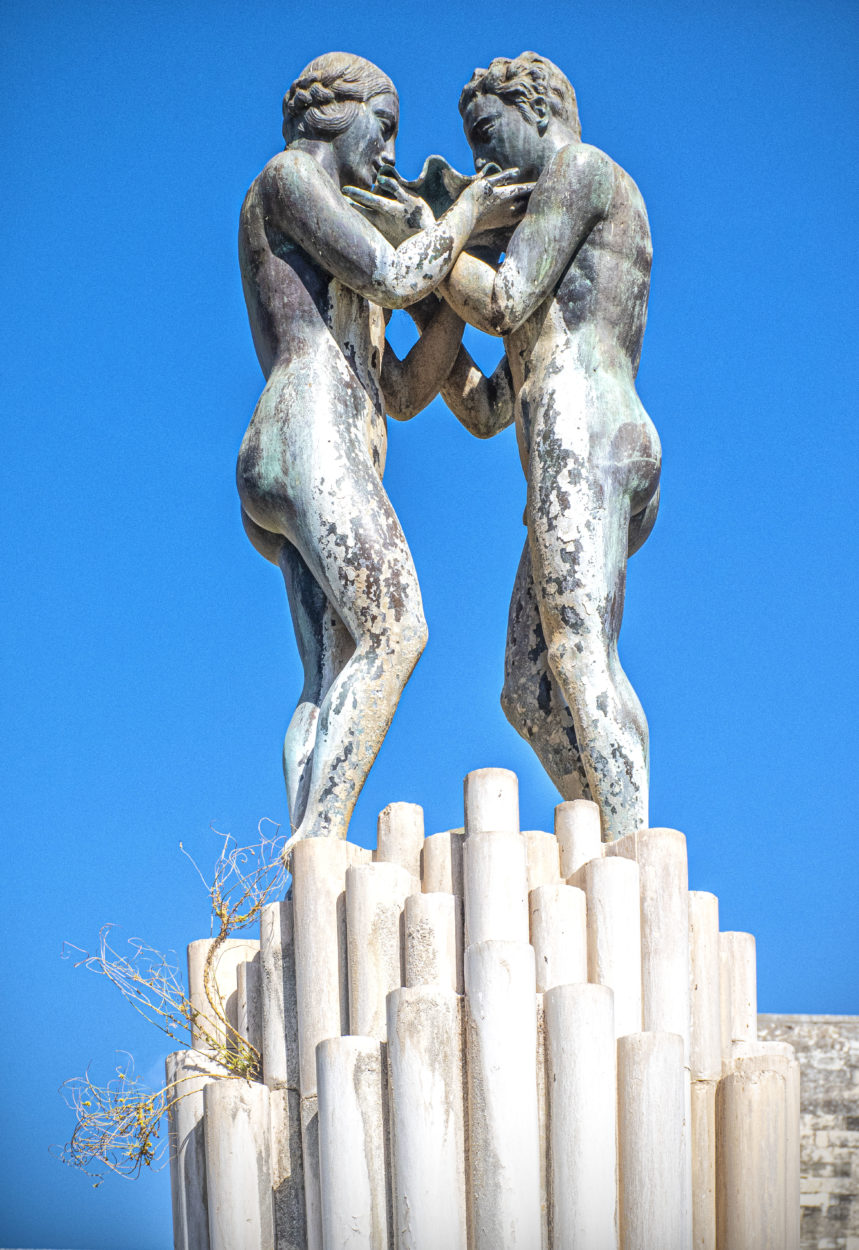
SCULTURAL DETAIL
There is an endless debate in the study of politics and history as to what constitutes a nation. To assume a homogeneity is to make a critical error. Nations are, like the people who live in them, very diverse in their nature. What appears to form a nation is a sharing of ideas that bond peoples together in a common search for a better tomorrow.
We feel richly blessed to have an opportunity to immerse ourselves in a culture quite distinct from the one in which we were raised. Travel is to be encouraged and even though short-term travel limits exposure, it can be a window on a recognition that in diversity there is an opportunity to experience new richness. For us, to have the luxury of a deeper immersion made possible with the freedom that comes with retirement, creates avenues for more in depth exposures that enriches life.
Retirement has been described by some as a “Third Epoch in Life.” There is infancy and then the years of raising a family and being employed. And then there is the opportunity to expand on all that has been experienced and learned and use it as a base to broaden experience and understanding. Time is a resource to be used constructively. What we decide to do with the time available to us, is a decision only we can make. We feel very fortunate to have the time that we have together.
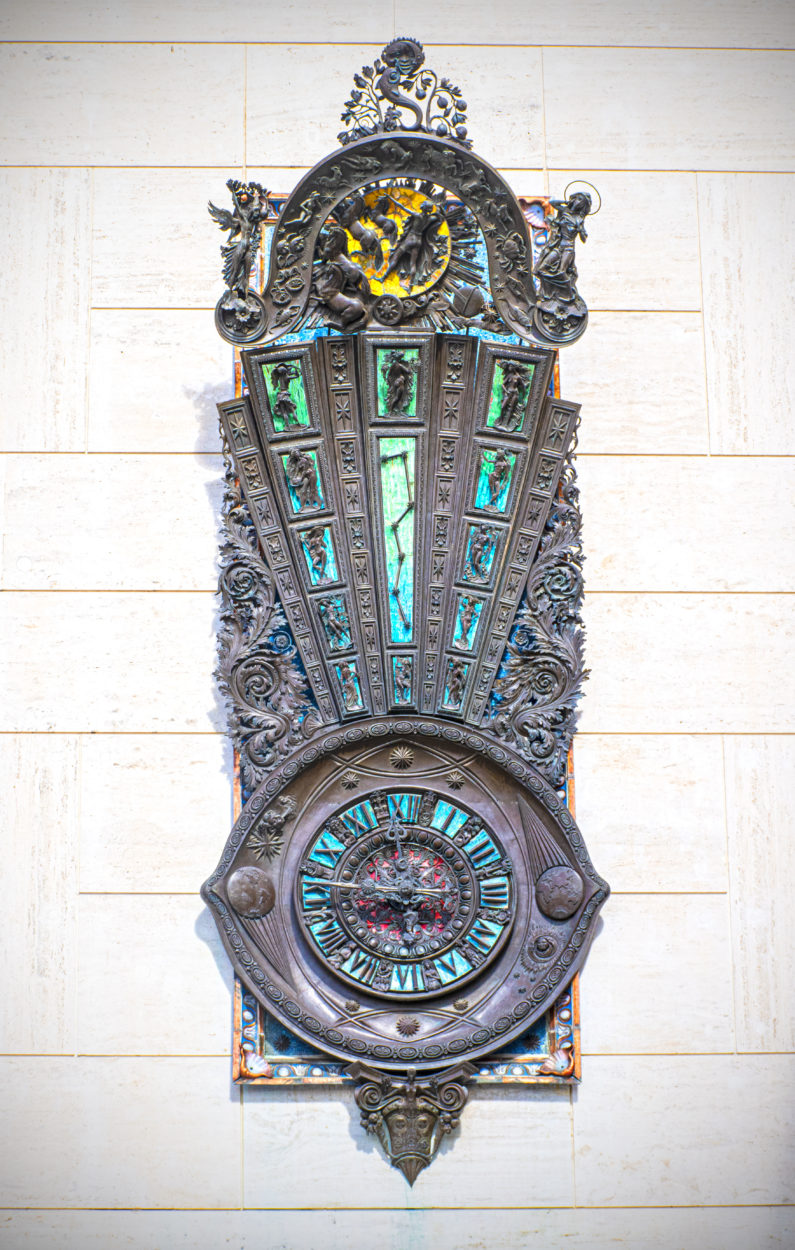
TIME – DEPICTED IN THE BAROQUE OF LECCE

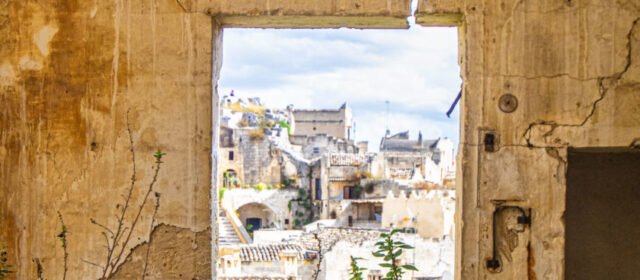
9 Comments
Carissimi – your poignant descriptions and stunning photos of your trip to my ancestral homeland of Puglia and to Basilicata were both inspiring and agonizing – inspiring because this post makes me want to hop in our car and drive down to revisit Puglia and Basilicata and stay in all of the accommodations Arlene found! And agonizing because we have been so long away from the beautiful diversity of our beloved Italy that you chronicled so well in this post. Missing you and Arlene so much!!! Thanks for this post – like Terri – this is my personal favorite!
We very much look forward to having your smiling faces back home here in Ascoli. Being with you and doing things together has always brightened our lives.
Larry & Arlene
Our sincere thanks to each of you who have taken the time to express your appreciation. As we have indicated previously, we started this blog both as a form of journal to help us remember and to have the economy of keeping friends and family informed without endless duplication of Emails. To find a wider circle of both old and new friends enjoying our efforts is very satisfying. Thank you all.
Larry and Arlene in Ascoli
Hello you two,
Jeff and I explored this area after we visited with you and Arlene in your charming town.. Our photos can’t compare with yours however. Larry, you are an excellent photographer and I love the way you frame a picture.
Stay safe. We really enjoy your posts.
Lynda H
Wonderful photos and so well documented as always we hope to visit Matera next time we are in Puglia . Bravo Larry and Arlene
I love all the descriptions in this blog, the history combined with the photos made me long to go back to Italy. I am so glad you both are having such a great retirement. Something I aspire to one of these days.
Thank you Larry for taking us along on your vacation. I feel as though I traveled with you and Arlene and saw many wonderful sites in Italy’s history. Your pictures are stunning and tell a story by themselves. Glad you are both well. Cheryl
Arlene & Larry, I so enjoyed this interesting travelogue, particularly the pictures of the stone roofs and buildings and caves, along with the historical facts. We are experiencing different parts of Italy through you.
Larry, by far my MOST enjoyed blog from you yet! Your descriptive flair made me yearn to be there. The photos are magnificent! Thank you for the tour of many places you visited. I lived vicariously through you and Jonsey while at the same time yearning to be there with you. Thank you! With regards to the reinstated quarantine, I fear this will soon be the case here. Dare I say……some people are just simply stupid! Sending my love to you and my dear friend, Arlene.